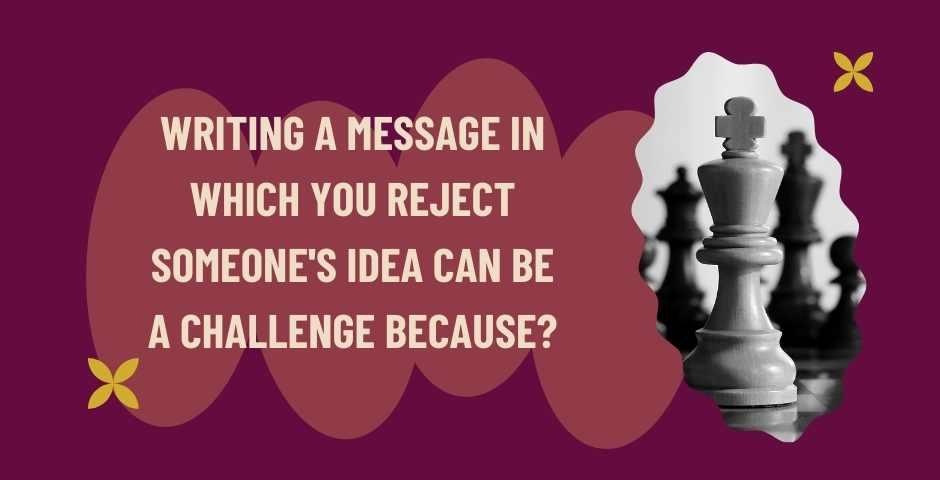Writing a Message in Which You Reject Someone's Idea Can be a Challenge Because?

Rejecting someone's idea can be challenging because it involves navigating delicate interpersonal dynamics, expressing disagreement without discouraging creativity, and maintaining a collaborative spirit.
Here are eight messages explaining why rejecting ideas is tough, written in detail to help understand the nuances of the challenge:
Message 1: Risk of Hurting Feelings
One of the primary reasons rejecting someone's idea is challenging is the fear of hurting their feelings.
Ideas are often personal, born from creativity and effort. When someone proposes an idea, it may carry emotional weight, reflecting their passion, values, or unique perspective.
Rejecting it, no matter how gently, can feel like a dismissal of their effort or worth, leading to discouragement or resentment.
This emotional aspect makes it necessary to handle rejections with care to preserve relationships and morale.
Message 2: Discouraging Future Contributions
Rejecting an idea poorly can discourage someone from contributing ideas in the future. When people feel their contributions are undervalued or dismissed without genuine consideration, they might hesitate to share their thoughts again.
This reluctance can stifle innovation and collaboration within a team or organization. A rejection, therefore, must be framed in a way that encourages continued engagement while addressing the concerns or limitations of the idea.
Message 3: Maintaining Team Dynamics
In a team setting, rejecting an idea can disrupt group dynamics if not handled delicately. A rejection perceived as harsh or dismissive may lead to friction, reduce trust, or create tension among team members.
It’s crucial to balance honesty with diplomacy, ensuring the individual feels respected and valued even if their idea isn’t accepted. Effective communication and empathy play key roles in maintaining a positive team atmosphere.
Message 4: Balancing Constructive Criticism and Politeness
Providing constructive criticism is an art that requires balancing honesty with politeness. While it's essential to point out why an idea might not work, doing so in a manner that feels overly critical can demoralize the individual.
Conversely, being overly polite without addressing the core issues may lead to misunderstandings or false expectations. Striking this balance is tricky and requires thoughtful phrasing and tone.
Message 5: Avoiding Miscommunication
Miscommunication is another challenge when rejecting an idea. If your reasoning isn’t clearly articulated, the person whose idea is being rejected might misinterpret your intentions or misunderstand the rationale.
They may feel their idea was dismissed arbitrarily or unfairly. To avoid this, it’s essential to provide a clear and logical explanation of why the idea isn’t feasible while ensuring that your message is understood as intended.
Message 6: Preserving Creativity and Innovation
Rejecting ideas too frequently or without sufficient thought can create an environment where creativity and innovation are stifled. People may begin to self-censor, withholding ideas they fear might be rejected.
It’s important to cultivate an atmosphere where all contributions are appreciated, even if not all are implemented. Emphasizing that every idea contributes to the collective brainstorming process helps sustain a culture of innovation.
Message 7: Addressing Power Dynamics
In hierarchical or power-imbalanced relationships, rejecting an idea can carry additional weight. For instance, when a manager rejects an employee’s idea, the employee might feel their opinions are undervalued or their expertise is questioned.
Conversely, rejecting a superior's idea can be intimidating, as it may affect one's standing or opportunities within an organization. Navigating these power dynamics requires tact and sensitivity to ensure fairness and mutual respect.
Message 8: Offering Alternatives or Compromises
When rejecting an idea, it’s often beneficial to propose alternatives or compromises, but doing so requires careful consideration and effort.
Simply saying “no” without suggesting other possibilities can feel dismissive. Offering a constructive alternative demonstrates that you value the individual’s input and are invested in finding a solution together.
However, crafting these alternatives takes time, creativity, and a deep understanding of the issue at hand.
The Art of Rejection
Rejecting someone’s idea is about more than just saying “no.” It’s about fostering understanding, preserving relationships, and encouraging ongoing collaboration.
By addressing these challenges thoughtfully, you can reject ideas in a way that promotes growth, innovation, and positive dynamics, turning a potentially difficult situation into an opportunity for mutual learning and development.


- Book Reviews & Literary Discussions
- Writing
- Reading List
- Arts and Entertainment
- Personal Development
- Storytelling
- Startup
- Books
- Biography
- Dance
- Drinks
- Entertainment & Pop Culture
- Health & Fitness
- Education & Learning
- Food & Cooking
- Games
- Gardening
- Self-Care & Mental Health
- Home Decor & DIY
- Literature
- Music
- Networking
- Other
- Party
- Philosophy and Religion
- Place
- Shopping
- Relationships & Dating
- Sports
- Theater
- lifestyles & hobbies/shutterbugs
- Lifelong Learning
- Tutorial
- Announcement
- Inspirational Stories & Motivation


